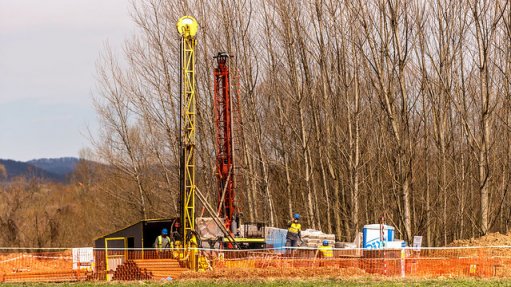
Exploration under way at Jadar, in Serbia
Mining major Rio Tinto is forecasting a “substantial” supply gap for lithium, which is experiencing rapid demand growth on the back of accelerating electric vehicle (EV) uptake, and argues that the gap has to be addressed “within the next ten years”.
In a trajectory toward net zero, the global share of light vehicle sales for EVs could exceed 50% as early as 2030, reaching up to 65-million units. This, Rio Tinto head of economics Vivek Tulpule says, would imply about three-million tonnes of lithium demand, compared with about 350 000 t today.
He points out in a slide presentation that lithium is expected to remain the preferred basis for battery chemistries in EVs. The expected future demand of solid-state batteries with improved energy density and safety performance could provide further upside, by increasing lithium intensity per kilowatt by more than 30%.
At the same time, lithium consumption per EV is growing as battery sizes increase to improve vehicle range.
On the supply side, Tulpule states that there are a variety of sources available and that there is “room for all of them”.
Existing operations and projects will contribute about one-million tonnes to supply, implying that a “substantial” gap will need to be filled, he notes.
In slides posted online, Tulpule notes that the supply gap will require ‘over 60 Jadar projects’, referring to Rio Tinto’s lithium project in Serbia.
He argues that committed supply and capacity expansions will contribute about 15% to demand growth over 2020 to 2050 and that the remaining 85% must come from new projects.
The Jadar project is one of the biggest greenfield lithium projects globally. Rio Tinto has committed $2.4-billion to the project, which will produce battery-grade lithium carbonate, positioning the group as the largest source of lithium supply in Europe for at least the next 15 years.
Jadar will also produce borates, which are used in solar panels and wind turbines.
First saleable production is expected in 2026. Following ramp up to full production in 2029, the Jadar mine will produce 58 000 t/y of lithium carbonate, 160 000 t/y of boric acid and 255 000 t/y of sodium sulphate.
Based on the yearly production of lithium carbonate, Rio Tinto aims to produce 2.3-million tonnes of lithium carbonate over the expected 40-year life-of-mine.
The price of lithium hydroxide continued to soar in 2021. Prices are at $23 375/t currently, up from an average of $6 300/t in the September quarter of 2020.
During the Mines and Money conference's battery metals session this week, Piedmont Lithium president and CEO Keith Phillips said the EVs market was fuelling the demand for lithium hydroxide. “I’ve always had the view that the market would speak, and the time would come, and it will,” said Phillips.
Phillips said Ford’s Blue Oval City required 125 000 t/y of lithium hydroxide to service its three battery plants, which surpasses the production capacities of all lithium projects currently planned in the US.